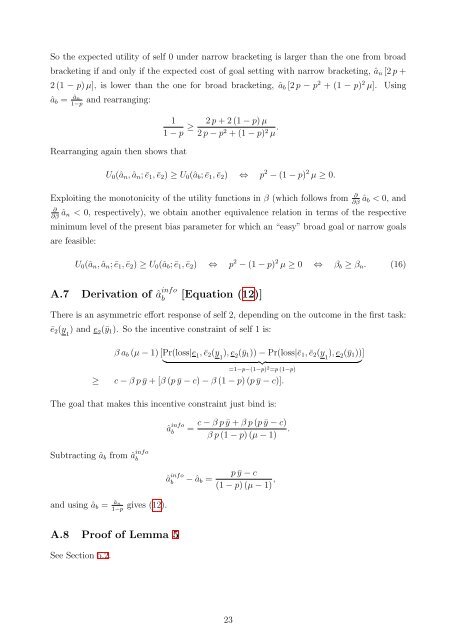Motivational Goal Bracketing - School of Economics and ...
Motivational Goal Bracketing - School of Economics and ...
Motivational Goal Bracketing - School of Economics and ...
You also want an ePaper? Increase the reach of your titles
YUMPU automatically turns print PDFs into web optimized ePapers that Google loves.
So the expected utility <strong>of</strong> self 0 under narrow bracketing is larger than the one from broad<br />
bracketing if <strong>and</strong> only if the expected cost <strong>of</strong> goal setting with narrow bracketing, ân [2 p +<br />
2 (1 − p) µ], is lower than the one for broad bracketing, âb [2 p − p 2 + (1 − p) 2 µ]. Using<br />
âb = ân<br />
1−p<br />
<strong>and</strong> rearranging:<br />
1<br />
1 − p<br />
Rearranging again then shows that<br />
≥ 2 p + 2 (1 − p) µ<br />
2 p − p 2 + (1 − p) 2 µ .<br />
U0(ân, ân; ē1, ē2) ≥ U0(âb; ē1, ē2) ⇔ p 2 − (1 − p) 2 µ ≥ 0.<br />
Exploiting the monotonicity <strong>of</strong> the utility functions in β (which follows from ∂<br />
∂β âb < 0, <strong>and</strong><br />
∂<br />
∂β ân < 0, respectively), we obtain another equivalence relation in terms <strong>of</strong> the respective<br />
minimum level <strong>of</strong> the present bias parameter for which an “easy” broad goal or narrow goals<br />
are feasible:<br />
U0(ân, ân; ē1, ē2) ≥ U0(âb; ē1, ē2) ⇔ p 2 − (1 − p) 2 µ ≥ 0 ⇔ βb ≥ βn. (16)<br />
A.7 Derivation <strong>of</strong> â info<br />
b<br />
[Equation (12)]<br />
There is an asymmetric effort response <strong>of</strong> self 2, depending on the outcome in the first task:<br />
ē2(y 1 ) <strong>and</strong> e 2(¯y1). So the incentive constraint <strong>of</strong> self 1 is:<br />
β ab (µ − 1) [Pr(loss|e1, ē2(y ), e<br />
1 2(¯y1)) − Pr(loss|ē1, ē2(y ), e<br />
1 2(¯y1)) ]<br />
<br />
=1−p−(1−p) 2 =p (1−p)<br />
≥ c − β p ¯y + [β (p ¯y − c) − β (1 − p) (p ¯y − c)].<br />
The goal that makes this incentive constraint just bind is:<br />
Subtracting âb from â info<br />
b<br />
<strong>and</strong> using âb = ân<br />
1−p<br />
gives (12).<br />
â info<br />
b<br />
â info<br />
b<br />
A.8 Pro<strong>of</strong> <strong>of</strong> Lemma 5<br />
See Section 5.2.<br />
c − β p ¯y + β p (p ¯y − c)<br />
= .<br />
β p (1 − p) (µ − 1)<br />
− âb =<br />
p ¯y − c<br />
(1 − p) (µ − 1) ,<br />
23
















